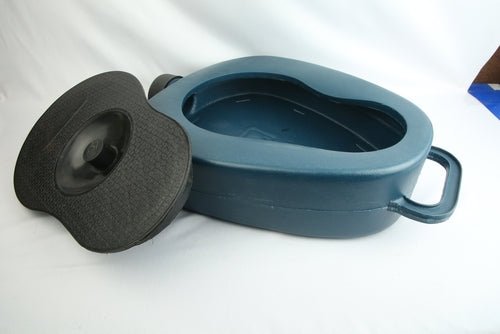
How to use a bedpan
Caring for bedridden patients is a journey of patience and understanding. When mobility is restricted, even the most private tasks become a collaborative effort, and this is especially true when it comes to using the toilet.
Using the bathroom is a daily task that many of us do in private. Asking for help from a carer or loved one can be difficult or embarrassing, particularly if the person is just beginning their journey with limited mobility.
That’s why bathroom aids, like bedpans, can make the process easier. Allowing users to conduct bathroom tasks in their own time and resting location gives them greater privacy and independence.
So, if you’re a carer looking for instructions on how to use a bedpan, stay with Millercare.
What is a bedpan?
A bedpan is a medical tool for bedridden individuals who can't access a regular toilet. It serves as a container for collecting urine and faeces, and there are two main types: reusable and disposable.
While the reusable bedpans need thorough cleaning after each use, disposable ones are discarded after a single use.
Reusable bedpans are designed to be used multiple times and are typically made from materials like stainless steel or plastic. After each use, they must be thoroughly cleaned and disinfected to prevent the spread of bacteria.
However, disposable bedpans are often manufactured using biodegradable materials and are a single-use-only product. They should be effectively discarded and offer users a convenient option that reduces the need for cleaning.
Bedpans are a mobility aid that’s been around for centuries, as early back as the 16th or 17th century! For more than 500 years, they have been a practical solution for individuals unable to use traditional toilet facilities due to illness, injury, or mobility issues.
Who uses bedpans?
There may be many reasons why someone cannot use traditional toilet facilities.
Bedpans are common in hospital facilities where patients recovering from lower-body surgery (e.g. hip fractures or leg breaks) are immobile for a short time. Care homes also use them to help individuals at high risk of injury.
Elderly patients who are significantly prone to falls or who might incur further injury by moving to a toilet may be safer in their day-to-day lives with access to a bedpan.
Even people experiencing profound fatigue, where moving to a toilet can be excessively taxing or unsafe, use bedpans.
How do bedpans work?
So, how do bedpans work? While it may be uncomfortable initially, using a bedpan can become a very easy process with continual use.
Usually, the caregiver will explain to their patient or loved one how the bedpan procedure works before ensuring they’re in a private environment. The bedpan (which may be warmed for comfort, depending on the material it’s manufactured from) is then placed under the patient.
They may need assistance to sit in a position that allows them to use the bedpan effectively. After use, the user can alert the caregiver, who can assist them off the bedpan and ensure they’re clean before disposing of the contents.
How to position a bedpan
The process of positioning a bedpan will vary from patient to patient. However, we can give caregivers a general overview of positioning a bedpan, and the instructions can be amended to accommodate more specific circumstances.
- Let your patient or loved one know what you’re about to help them with and how you will proceed.
- Sanitise your hands and wear a pair of disposable gloves for protection.
- This step is optional and depends on whether you have the resources. If you have access to talcum powder, apply a thin coating to the rim of the bedpan; this will make it easier to slide the device underneath the patient.
- Fill the bedpan with enough water to cover the bedpan before positioning.
- Help the patient remove any lower-body clothing (if they cannot do this themselves).
- Use a blanket or sheet to cover the patient’s lower body and give them space. Ensure you stay close by, or give the patient a way to alert you once they’re finished.
How to use a bedpan
Now that you know how to position a bedpan, what is the best way for them to utilise it? Again, these instructions will vary depending on the person’s physical condition and the type of bedpan they’re using.
- If possible, the user should lie on their back with their knees bent and feet flat on the bed’s surface.
- Place your filled bedpan close to the patient's hips and check that the curved edge faces the back.
- When it comes to positioning the patient onto the bedpan, there are two options dependent on physical ability:
a. (Patients who can move their hips): Instruct the user to lift their hips and slide the bedpan under the patient's bottom. They can then lower onto the bedpan.
b. (Patients who cannot move their hips): Whether on your own or with assistance, slowly roll the patient onto their side, placing the bedpan gently against their hips before rolling them back towards you and onto the device.
Shop for male and female bedpans and commodes with Millercare
Bedpans can improve the lives of patients and caregivers with their convenience. Whether you choose reusable or disposable commodes, these devices help people with limited mobility perform daily tasks more independently.
At Millercare, we appreciate the importance of these bathroom aids and have cultivated a collection of industry-leading products for male and female patients. With brands like Aidapt, Able 2 and Warwick Sasco, you have access to some of the best products on the market.